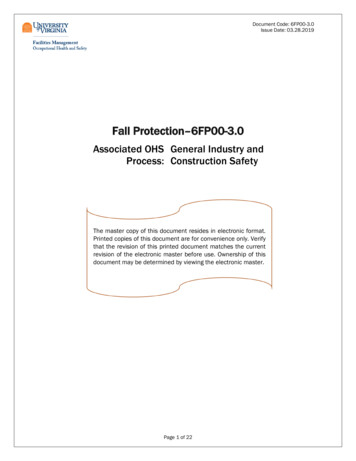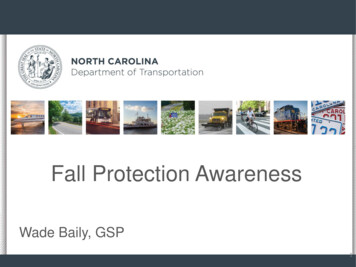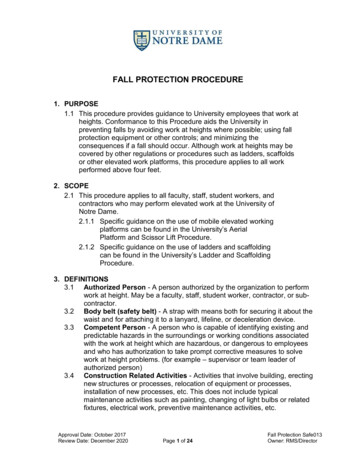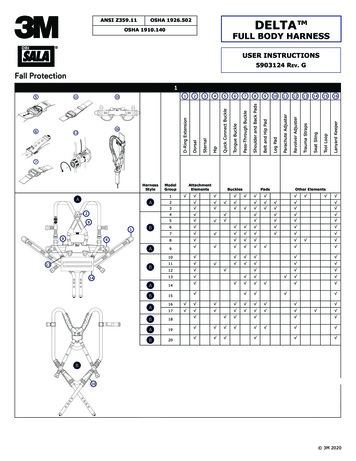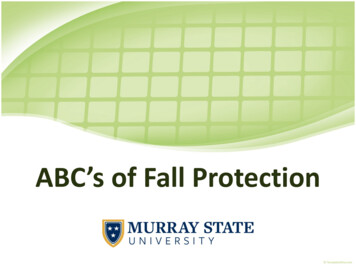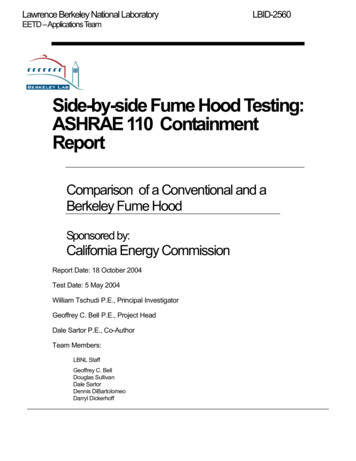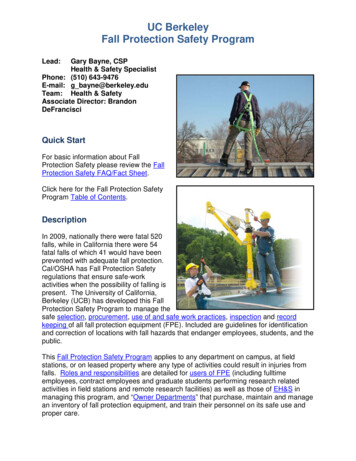
Transcription
UC BerkeleyFall Protection Safety ProgramLead:Gary Bayne, CSPHealth & Safety SpecialistPhone: (510) 643-9476E-mail: g bayne@berkeley.eduTeam: Health & SafetyAssociate Director: BrandonDeFrancisciQuick StartFor basic information about FallProtection Safety please review the FallProtection Safety FAQ/Fact Sheet.Click here for the Fall Protection SafetyProgram Table of Contents.DescriptionIn 2009, nationally there were fatal 520falls, while in California there were 54fatal falls of which 41 would have beenprevented with adequate fall protection.Cal/OSHA has Fall Protection Safetyregulations that ensure safe-workactivities when the possibility of falling ispresent. The University of California,Berkeley (UCB) has developed this FallProtection Safety Program to manage thesafe selection, procurement, use of and safe work practices, inspection and recordkeeping of all fall protection equipment (FPE). Included are guidelines for identificationand correction of locations with fall hazards that endanger employees, students, and thepublic.This Fall Protection Safety Program applies to any department on campus, at fieldstations, or on leased property where any type of activities could result in injuries fromfalls. Roles and responsibilities are detailed for users of FPE (including fulltimeemployees, contract employees and graduate students performing research relatedactivities in field stations and remote research facilities) as well as those of EH&S inmanaging this program, and “Owner Departments” that purchase, maintain and managean inventory of fall protection equipment, and train their personnel on its safe use andproper care.
UC BerkeleyFall Protection Safety ProgramTable of Contents[CLICK ON ANY ENTRY IN THE TABLE OF CONTENTS TO BE TAKEN TOTHAT SECTION OF THE PROGRAM.]Quick Start . 1Table of Contents . 2Purpose/Introduction . 3Applicability/Scope . 3Roles/Responsibilities . 3Every User of Fall Protection Equipment (FPE) . 4Owner Department. 4EH&S . 5Definitions . 6Types of Fall Protection Equipment (FPE) . 11Fall Arrest System. 11Positioning System . 12Suspension System . 13Selection/Procurement of FPE . 14Fall Hazard Assessment . 14FPE Types and Selection for Use . 16Harnesses . 16Connectors. 19Rescue Devices . 23Anchors . 25Accessories and Their Uses . 28Fall Protection Systems . 29Program Requirements/Procedures . 31Owner Department Requirements . 31Fall Protection User’s Procedures. 31Rescue Plan . 31Fall Protection Equipment User’s Safe-Work Rules. 32FPE Maintenance and Care . 33Fall Protection – When working from ladders. . 33Training Requirements . 33Record Keeping Requirements . 34References . 35Issued By and Next Review Date . 36Attachment 1 – FPE Identification Numbering System . 37Attachment 2 – Inspecting Fall Protection Equipment . 38Attachment 3 – Cleaning Fall Protection Equipment . 41Attachment 4 – Safe-Work Rules For Use of a Ladder . 42Attachment 5 – Fall Hazard Analysis. 43Attachment 6 – Fall Protection Rescue Plan . 44
UC BerkeleyFall Protection Safety ProgramPurpose/IntroductionFalls present significant workplace hazards. The Federal Bureau of Labor Statisticsstates that in 2009, 608 people died from falls. That’s 14% of the total workplacefatalities in the USA that year! In California, of the 54 falls that occurred that year, 41could have been avoided by proper use of fall protection equipment (FPE).The use of fall protection equipment (FPE) poses physical and physiological hazardsthat could result in permanent injury or death to the wearer when used incorrectly orwithout adequate preparation for rescue after a fall.The University of California, Berkeley (UCB) developed this program to describe allaspects of secondary FPE use, inspection, personnel accountability for the conditionand use of the equipment, safe work practices, training requirements, and recordkeeping.Go to Quick StartGo to Table of ContentsGo to FAQ Fact SheetApplicability/ScopeThere are two types of FPE, primary and secondary. Primary FPE refers to stationaryobjects that act as engineering controls for the prevention of falls. This includesguardrails, floors, ramps, platforms, and lifts or scaffolding. Secondary FPE refers todevices attached to structures whose sole use is for fall protection anchorages, and anydevices used for fall protection that a user attaches to them (lanyards harnesses, elbowstraps, etc.). This program primarily applies to secondary fall protection equipmentworn by the FPE user and attached to structural anchor points.This Program applies to any activities being conducted in elevated locations byUniversity personnel where fall hazards that require wearing of FPE for protection arepart of research/work activities. This includes contract employees and graduatestudents performing research related activities in field stations and remote researchfacilities.Go to Quick StartGo to Table of ContentsGo to FAQ Fact SheetPage 3 of 48
UC BerkeleyFall Protection Safety ProgramRoles/ResponsibilitiesEvery User of Fall Protection Equipment (FPE)FPE users are required to follow safe-work procedures as outlined in this program, toalert Owner Department management whenever they discover damaged equipment andto follow the safe work practices developed by their department concerning fallprotection use. Toward this end, FPE users: Are trained on and apply the “Fall Protection Equipment User’s Safe-work Rules”for FPE equipment useDocument the use of the Department’s Rescue Plan and when it applies to theirwork activitiesAlways select, inspect, and use FPE in a safe mannerAlert Owner-Department Management when FPE has any damage or weaknessrequiring repair/replacementAssess planned work to determine if FPE should be worn, and seek alternativeaccess or work-methods to avoid the use of FPE whenever possibleRefuse to do unsafe work using FPE. And, instead, use other methods of accesssuch as a scaffold, lift pod or bucket truck and thus avoid the need to use FPE.Go to Quick StartGo to Table of ContentsGo to FAQ Fact SheetOwner DepartmentThe “Owner Department” is responsible to identify fall hazards/activities in theirworkplace and design into locations engineering controls such as guardrails, fallbarriers, edge protection, etc., to prevent access to a fall hazard. Only whenengineering controls cannot be used/implemented is FPE to be used to control fallhazards to personnel in a Department’s operations/facilities.The department owning or exposing personnel to fall hazards is responsible for theselection of the proper FPE based upon a hazard analysis of work tasks. In addition,Owner Departments must provide training to their personnel who use the equipment,keep the records of training completed, and schedule semi-annual inspections of allFPE under their ownership/control.Toward this end, the Department owning the FPE must: Assign a Fall Protection Program Administrator to manage the Program for theDepartmentAssure work-tasks are evaluated for hazards and that work tasks requiring fallprotection to be worn are identifiedPage 4 of 48
UC BerkeleyFall Protection Safety Program Provide alternative access when an FPE user determines use of FPE can beavoided by providing other means of access or workspace operations such as ascaffold, lift pod or bucket truckEstablish a general Rescue Plan and include its adaptation to specific FPE usesitesNotify EH&S when new equipment is purchased so that it can be inspected by acertified FPE inspector and added to the EH&S FPE inventorySchedule with EH&S a semi-annual inspection by a certified FPE inspector for allFPE in their control/ownershipRender unusable and then dispose of any FPE that is in any way questionablysafe as determined by a certified FPE inspector or the person using theequipmentProvide training to all personnel using their FPE as required by the “Training”section of this ProgramKeep attendance records of all trainingGo to Quick StartGo to Table of ContentsGo to FAQ Fact SheetEH&S Works with UCB Risk Management Department, Procurement Department, FPEmanufacturers, and the Owner Department to determine proper FPE selection,use, stocking, and safe-work practices unique to the Owner Department’s workactivitiesPerforms and documents semi-annual inspections of FPEMaintains campus inventory data base of FPE and inspection recordsProvides training to assist Owner Departments in FPE Program complianceMaintains and updates this Program as need dictates, or as compliance codeschangeGo to Quick StartGo to Table of ContentsGo to FAQ Fact SheetPage 5 of 48
UC BerkeleyFall Protection Safety ProgramDefinitionsApprovedTested and approved by a Nationally Recognized Testing Laboratory (NRTL) such asUnderwriters Laboratory (UL) or Gravitec.AnchorageA secure point of attachment for lifelines, lanyards or deceleration devices. May also bea “Bearer Bracket” or a “Roofing Bracket”.Bearer BracketA bracket used in slope roof construction, having provisions for fastening it over theroof-ridge and being secured to some suitable object; also known as “Roofing Bracket”.Body BeltA simple or compound strap with means for securing it about the waist and for securinga lanyard to it. The use of a body belt for fall restraint/prevention is allowed, but itcannot be used for fall arrest.Body HarnessStraps which may be secured about a person’s torso and buttocks in a manner that willdistribute the fall arrest forces over at least the thighs, pelvis, waist, chest and shoulderswith means for attaching it to other components of a personal fall arrest system.BuckleAny device for holding the body belt or body harness closed around the employee'sbody.Go to Quick StartGo to Table of ContentsGo to FAQ Fact SheetCatenary LineSee “Lifeline”.CarabineerSee “Snaphook”.Page 6 of 48
UC BerkeleyFall Protection Safety ProgramFree-FallThe act of falling before a personal fall arrest system begins to apply force to arrest thefall.Free-Fall DistanceThe vertical displacement of the fall arrest attachment point on the employee's body beltor body harness between onset of the fall and just before the system begins to applyforce to arrest the fall. This distance excludes deceleration distance, and lifeline/lanyardelongation, but includes any deceleration device slide distance or self-retractinglifeline/lanyard extension before they operate and fall arrest forces occur.GuardrailA barrier consisting of a top rail and a midrail secured to uprights and erected along theexposed sides and ends of platforms.HandrailA rail used to provide employees with a handhold for support.Go to Quick StartGo to Table of ContentsGo to FAQ Fact SheetHoleAny area in a floor or platform that is open to an area below but is smaller in size thanan “opening” as defined by the Cal/OSHA Fall Protection codes.LanyardA flexible line to secure a wearer of a safety belt or harness to a drop line, lifeline, orfixed anchorage.Leading EdgeThe edge of a floor, roof, or formwork for a floor or other walking/working surface (suchas the deck) which changes location as additional floor, roof, decking, or formworksections are placed, formed, or constructed. A leading edge is considered to be an“unprotected side and edge” during periods when it is not actively and continuouslyunder construction.LifelineUsually a horizontal steel-wire rope (i.e. Catenary line) located between two fixedanchorages and suspended above the work surface, to which the lanyard is securedPage 7 of 48
UC BerkeleyFall Protection Safety Programeither by tying off or by means of a suitable sliding connection. A lifeline may be verticalwhen used with a rope-grab attached by lanyard to a body harness.Linemen's Body BeltA leather or web (cotton or nylon) belt designed specifically for employees working onpoles. It consists of a waist belt, generally cushioned, with a front buckle, two D ringsfor attaching safety straps and a multiple-looped strap for holding, rings, snaphooks,holsters and other tool holding devices.Lower LevelsThose areas or surfaces to which an employee can fall. Such areas or surfacesinclude, but are not limited to, ground levels, floors, platforms, ramps, runways,excavations, pits, tanks, material, water, equipment, structures, or portions thereof.MidrailA rail approximately midway between the top rail and platform that is secured to theuprights erected along the exposed sides and ends of platforms.Go to Quick StartGo to Table of ContentsGo to FAQ Fact SheetOpeningAn open area in any floor or platform 12 inches or more in the least horizontaldimension. It includes: stairway floor openings, ladder-way floor openings, hatchwaysand chute floor openings.Personal Fall Arrest SystemA system used to slow and stop a person during a fall from elevated location. Itconsists of an anchorage, connectors, a body harness, and may include a lanyard,deceleration device, lifeline, or suitable combinations of these. The use of a body beltfor fall arrest is prohibited by law.Personal Fall Restraint SystemA system used to prevent an employee from access to a leading edge or other fallhazard location. It consists of anchorages, connectors, body belt/harness. It mayinclude, lanyards, lifelines, and rope grabs designed for that purpose.Personal Fall Protection SystemA generic term for any designed fall protection system that might include fall arrestsystems, positioning device systems, fall restraint systems, safety nets, guardrails, etc.Page 8 of 48
UC BerkeleyFall Protection Safety ProgramPersonal Protective Equipment (PPE)As this term applies to Fall Protection Equipment, it defines the safeguarding obtainedby use of fall protection safety devices worn by a person and that safeguards them froma fall hazard, and is of such design, strength, and quality as to eliminate, preclude, ormitigate the hazard.Positioning Device SystemA body belt or body harness system rigged to allow an employee to be supported on anelevated surface, such as a wall, and work with both hands free while leaning.Qualified Person, Attendant or OperatorA person designated by the Owner Department who, by reason of training, experienceor instruction, has demonstrated the ability to safely perform all assigned duties and,when required, is properly licensed in accordance with federal, state, or local laws andregulations.Go to Quick StartGo to Table of ContentsGo to FAQ Fact SheetRailing(See “Guardrail”)RampA surfaced sloping passageway connecting two different levels.Roofing Bracket(See “Bearer Bracket”).RopeRefers to steel-wire rope unless otherwise specified.Rope GrabA deceleration device which travels on a vertical lifeline and automatically, by friction,engages the lifeline and locks so as to arrest the fall of an employee. A rope grabusually employs the principle of inertial locking, cam/level locking, or both.Go to Quick StartGo to Table of ContentsGo to FAQ Fact SheetPage 9 of 48
UC BerkeleyFall Protection Safety ProgramSafety Belt or HarnessA device specifically for the purpose of securing, suspending, or retrieving a worker in orfrom a hazardous work area.Safety FactorRatio of the ultimate breaking strength of a structural member, piece of material orequipment to the actual working stress or safe load when in use.Safety LineA vertical line most often of polypropylene or other woven synthetic material provided toprotect a person from falls caused by failure of suspended scaffolds, working platforms,or loss of balance, and that extend to within four feet of ground or other stable rescuesurface.Self-Retracting Lifeline/LanyardA deceleration device containing a drum-wound line which can be slowly extracted from,or retracted onto, the drum under slight tension during normal movement by theuser/wearer, and which, after onset of a fall, automatically locks the drum and arreststhe fall.Safety StrapA web strap designed specifically for use in conjunction with a lineman's belt as an aidin climbing poles and to secure the employee to the pole in a manner that permitshands-free work using both hands.SnaphookA connector comprised of a hook-shaped member with a normally closed keeper, orsimilar arrangement, which may be opened to permit the hook to receive an object and,when released, automatically closes to retain the object; also known as a “Carabineer”.Unprotected Sides and EdgesAny side or edge (except at entrances to points of access) of a walking/working surface(e.g., floor, roof, ramp, or runway) where there is no wall or standard guardrail provided.Wall openingA gap or void 30 inches or more high and 18 inches or more wide, in a wall or partition,through which employees can fall to a lower level.Go to Quick StartGo to Table of ContentsGo to FAQ Fact SheetPage 10 of 48
UC BerkeleyFall Protection Safety ProgramTypes of Fall Protection Equipment (FPE)A Personal Fall Protection System is comprised of three (3) key components:1. Anchorage connector2. Body wear3. Connecting device to join themFPE is selected and used to meet the design requirements for the following fourcategories of Fall Protection Systems:Go to Quick StartGo to Table of ContentsGo to FAQ Fact SheetFall Arrest SystemA personal Fall Arrest System is used to slow and stop a person during a fall from anelevated location. As a general rule, it is recommended that a Fall Arrest System beused at working heights of four (4) feet or more; however, regulatory agencies vary theheight-use requirements based on tasks or industries. Contact EH&S to assurecompliance with codes prior to procuring and using Fall Arrest Equipment. The FallArrest System consists of:Anchorage(Anchorage connector)Connecting device(Shock-absorbing lanyard)(Self-retracting lifeline)Body wear(Full-body harness)Page 11 of 48
UC BerkeleyFall Protection Safety ProgramPositioning SystemA positioning system is used to hold a worker in placewhile allowing a hands-free work environment at elevatedheights. The positioning systems are not designed for fallarrest and, therefore, a back-up fall arrest system must beused. A typical positioning system consists of:Anchorage/anchorage connectorBody wear (full-body harness)Connecting device (positioning lanyard)Go to Quick StartGo to Table of ContentsGo to FAQ Fact SheetRestraint SystemA restraint system is used to restrict the worker’s movement to prevent reaching alocation where a fall hazard exists. The restraintsystems are not designed for fall arrest and,therefore, a back-up fall arrest system must beused. A typical restraint system consists of:Body wear (full-body harness or body belt)Connecting device (restraint lanyard)Anchorage/anchorage connectorHorizontal Fall LinePage 12 of 48
UC BerkeleyFall Protection Safety ProgramSuspension SystemSuspension systems are used widely in the windowwashing and painting industries and are designedto lower and support a worker while allowing ahands-free work environment. The positioning andsuspension systems are not designed for fall arrestand, therefore, a back-up fall arrest system must beused. A typical suspension system includes:Anchorage/anchorage connectorBody wear (full-body harness)Suspension device (Boatswain chair)Go to Quick StartGo to Table of ContentsGo to FAQ Fact SheetRetrieval SystemThe retrieval system is primarily used in confined space applications where workersmust enter tanks, manholes, etc., and may require retrieval from above should anemergency occur. Retrieval Systems may also be used in rescue after a fall hasoccurred and the victim is hanging by the Fall Arrest System in suspension. A retrievalsystem typically consists of:AnchorageAnchorageconnector(Tripod, davit)Connecting device(Retrieval unit)Body wear(Full-body harness)Page 13 of 48
UC BerkeleyFall Protection Safety ProgramSelection/Procurement of FPEFPE is designed and constructed according to the American National StandardsInstitute (ANSI) standards to safely hold greater than twice the expected load inpositioning systems and a specific amount of weight in fall arrest systems in the event ofa fall. The design-load capacity includes a person's fully clothed weight plus the weightof any tools and materials that are carried that could be part of the load on the FPEduring a fall.Go to Quick StartGo to Table of ContentsGo to FAQ Fact SheetFall Hazard AssessmentCode requires the load rating must be attached or permanently printed on each piece ofequipment and must be readable by the person using the equipment. The user must beable to plan the use of the equipment based on the load capacity. The kind of personalfall arrest system selected should match the particular work situation, and any possiblefree fall distance should be kept to a minimum. Consideration must be given to theparticular work environment, the presence of acids, dirt, moisture, oil, grease, etc., andtheir effect on the system. Hot or cold environments may also have an adverse effecton the system. Wire rope should not be used where an electrical hazard is anticipated,etc.Listed below are different types of fall safety equipment and their recommended usage.Harnesses and BeltsClass 1Class 2Class 3Class 4Body belts (single or double D-ring) are designed torestrain a person in a hazardous work position and toreduce the possibility of falls. They should not be usedwhen a fall potential exists; positioning only.Chest harnesses are used when there are only limitedfall hazards (no vertical free fall hazard) or for retrievingpersons such as removal of persons from a tank or a bin.Full body harnesses are designed to arrest the mostsevere free fallsSuspension belts are independent work supports used tosuspend a worker, such as boatswain's chairs or raisingor lowering harnesses.Page 14 of 48
UC BerkeleyFall Protection Safety ProgramGo to Quick StartGo to Table of ContentsGo to FAQ Fact SheetConnectorsRope LanyardOffers some elastic properties for fall arrest; used forrestraint purpose.Web LanyardIdeal for restraint purposes where fall hazards are lessthan two feet.Cable Positioning Lanyards Designed for corrosive or excess heat environments andmust be used in conjunction with shock absorbingdevices.Shock AbsorbersWhen used, the fall arresting force will be greatlyreduced if a fall occurs.Rope GrabsA deceleration device which travels on a lifeline, used tosafely ascend or descend ladders or sloped surfaces andautomatically, by friction, engages the lifeline and locksso as to arrest the fall of an employee.Retractable Lifeline Systems Gives fall protection and mobility to the user when(self-retracting lanyard)working at height or in areas where there is a danger offalling.GuardsSafety NetsRail SystemsGo to Quick StartCan be used to lessen the fall exposure when workingwhere temporary floors and scaffolds are not used andthe fall distance exceeds 25 feet.When climbing a ladder, rail systems can be used on anyfixed ladder as well as curved surfaces as a reliablemethod of fall prevention.Go to Table of ContentsGo to FAQ Fact SheetPage 15 of 48
UC BerkeleyFall Protection Safety ProgramFPE Types and Selection for UseHarnessesVest HarnessA harness is built into the vest to create ano-tangle body wear system.The leg straps of the Vest Harness zip intothe back of the harness for easy storagewhen not in use.Used the same as any other fall protectionharness, but offers pockets and can bevisibility vests for use on construction sites.Retrieval harnessThis harness has spring loaded "stand-up"dorsal retrieval D-rings for quick rescue inthe event of a fall or retraction (retrieval)from a confined spaceCan be used as a fall arrest harness inman-holes and other confined spaces.Go to Quick StartGo to Table of ContentsGo to FAQ Fact SheetPage 16 of 48
UC BerkeleyFall Protection Safety ProgramWelding HarnessEdge Flame Resistant Harness is designedwith welding applications in mind andfeatures a replaceable outer shell to prolongthe life of the harness by shielding thewebbing from high intensity ultraviolet light,slag, and sparks produced by welding.Used as a fall protection harness on steelstructures such as bridges where theperson wearing the harness is welding.Tower HarnessTower Harness for climbing, workpositioning, and suspension has an extracomfortable saddle and a body belt forpositioning.Typically used on broadcast towers andtheater/concert production in instanceswhere lifelines and positioning/restraintsystems are used.Go to Quick StartGo to Table of ContentsGo to FAQ Fact SheetPage 17 of 48
UC BerkeleyFall Protection Safety ProgramBody BeltBody belts can only be used for fall restraintor positioning systems, not for fall arrest.Body belts (single or double D-ring) aredesigned to restrain a person in ahazardous work location and to reduce theirinadvertent access to a fall hazard.Lineman HarnessThe extra wide cradle seat adds comfort tothe lineman harness and includes fourattached side positioning D-rings and apermanently attached tool belt.These are mostly used for work from polesor in trees.Go to Quick StartGo to Table of ContentsGo to FAQ Fact SheetJacket HarnessThe outer shell of this harness's jacket isdesigned to protect the person wearing itfrom wind and rain, and the accessory flapsprevent rain from getting inside their jacket.These are similar to a vest harness as theyare used the same as any other fallprotection harness, but offers pockets andcan be in orange visibility coloration for useon construction sites.Page 18 of 48
UC BerkeleyFall Protection Safety ProgramConnectorsFall limiterA short version of a self-retracting lanyard.The one shown here is attached to anelbow strap around the beam.These are used in lieu of shock absorbinglanyards. They are designed to lock quicker(within two inches) than ch?v cIPMQ4YZEARope Grab LanyardA deceleration device which travels on alifeline used to safely ascend or descendladders or sloped surfaces andautomatically, by friction, engage the lifelineand lock so as to arrest the fall of anemployee.These are used for fixed ladders.Go to Quick StartGo to Table of ContentsGo to FAQ Fact SheetPage 19 of 48
UC BerkeleyFall Protection Safety ProgramCab Mount LanyardDesigned to secure an operator into a cabof a forklift as shown in the picture.It is a version of a fall-limiter. They aredesigned to lock quicker (within two inches)than self-retracting lanyardsSelf-Retracting LanyardA Retractable Lifeline System that gives fallprotection and mobility to the user whenworking at height or in areas where there isa danger of falling.Go to Quick StartGo to Table of ContentsGo to FAQ Fact SheetPage 20 of 48
UC Berk
Fall Protection Safety Program Lead: Gary Bayne, CSP Health & Safety Specialist . Phone: (510) 643-9476 . E-mail: g_bayne@berkeley.edu . Team: Health & Safety . Associate Director: Brandon DeFrancisci . Quick Start . For basic information about Fall Protection Safety please review the .
